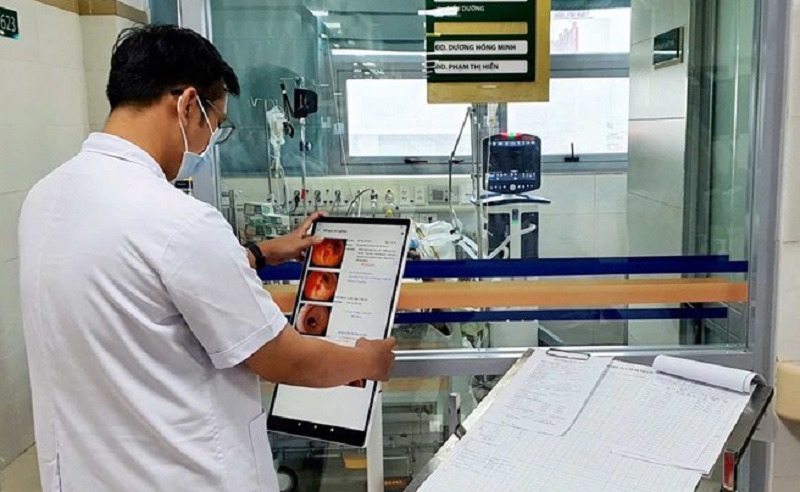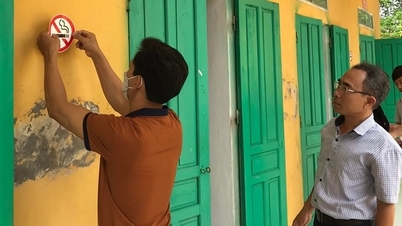Big changes with electronic medical records
Previously, people coming to the Central Endocrinology Hospital for examination often had to wait for examination, X-rays, tests and results for a long time because the hospital was overloaded, but since the implementation of electronic medical records, the examination and treatment process has changed, greatly reducing waiting time for patients.
Having thyroid disease and having to regularly visit the Central Endocrinology Hospital for check-ups, Ms. Nguyen Thi Huong Giang (31 years old, Tay Mo, Hanoi ) was surprised when the medical examination process changed significantly. “Before, when I came for a check-up, I had to queue up to get a number, but now I only use my ID card to get a number, and when paying for hospital fees, I just need to scan the QR code. The examination, imaging, and testing process is much faster. Normally, it takes me all day to finish the examination, but today I came for a check-up and did many specialized tests, and I finished them all by early afternoon,” Ms. Giang shared.

Ms. Nguyen Thi Thuan (Dong Anh, Hanoi) has type 2 diabetes and has to go to the Central Endocrinology Hospital every month for check-ups. She said: “Before, every time I was examined, when I was ordered an ultrasound or X-ray, I had to run to each place to get the results. Now the results are sent to the initial doctor's office, and the patient gets the results right here. Before, I had to wait all morning for the examination, but now the procedures are over in just over an hour. Patients download the application to their phones and update their examination results and prescriptions on their phones, which is very convenient.”
Dr. Do Van Ky, Head of the Examination Department, Central Endocrinology Hospital, said that every day the hospital receives 2,000-2,800 outpatients and about 1,000-1,100 inpatients. Deploying electronic medical records has helped doctors to systematically summarize the entire medical history, test charts and treatment process of the patient, thereby devising a treatment strategy, especially beneficial for patients with thyroid cancer and diabetes.
“Electronic medical records help doctors develop treatment strategies, personalize treatment for each patient, and minimize professional errors. Through the warning system, doctors are warned about drug interactions and tests to make sure they do not have duplicate prescriptions,” Dr. Ky added.
Visiting the Hanoi Oncology Hospital, Ms. Nguyen Thi Ly ( Quang Ninh ) said that since the implementation of electronic medical records, the medical examination process has saved patients 1-3 hours of waiting and receiving results. The shortened time helps out-of-town patients return home early.
According to the request of the Ministry of Health , after implementing electronic medical records, hospitals must connect data, helping patients avoid having to redo existing tests. This is a very large database system, the connection brings many benefits to treatment, at the same time, it also increases transparency in health insurance management, reducing complicated administrative procedures.
According to Dr. Do Van Ky, when connecting data, from the connection of software on electronic medical records, doctors can consult online from inter-department, whole hospital, inter-hospital. However, up to this point, many hospitals have not connected data because of ensuring confidentiality and information security, therefore, there must be clear regulations as well as instructions from the Ministry of Health and functional units for the hospital to implement.
Not completed due to lack of funds
As of October 5, 1,002 out of 1,645 hospitals nationwide have implemented electronic medical records, while more than 640 hospitals are behind schedule as required by the Government (before September 30, all hospitals nationwide must implement). Many hospitals said that implementing electronic medical records requires a large initial investment, while hospital resources are limited.
Currently, there is no specific guidance on the financial mechanism for the application of information technology (IT) in healthcare in general and the implementation of electronic medical records in particular. The cost of medical services has not yet taken into account the IT cost component, therefore, hospitals mainly have to use the unit's development investment fund, affecting other essential activities.
Talking about the difficulties leading to this delay, Mr. Nguyen Ba Hung, Head of the Department of Digital Transformation of Healthcare, National Center for Health Information (Ministry of Health) said that district-level hospitals have many difficulties in terms of funding for IT infrastructure investment and information security assurance. The current IT infrastructure of many hospitals is not synchronized, the server system and accompanying equipment were invested a long time ago, low configuration, not meeting the requirements for implementing electronic medical records. In addition, the cost of investing in solutions to ensure information security and network security is also very high, exceeding the capacity of many medical facilities. Therefore, despite the determination to implement, many hospitals still face obstacles in terms of resources, leading to slow progress.
To accelerate and reach the finish line in the near future, according to Mr. Hung, hospitals need to conduct thorough surveys and make systematic investment plans. Lower-level hospitals should take advantage of cloud computing infrastructure to reduce investment and operating costs. IT staff must be highly trained and knowledgeable in both medical and technological operations to act as a bridge with software providers. They must regularly train medical staff and coordinate with departments and offices to develop standard operating procedures for electronic medical records.
Regarding mechanisms and policies, according to Associate Professor, Dr. Tran Quy Tuong, Chairman of the Medical Informatics Association, the Ministry of Health needs to develop, supplement and perfect mechanisms, policies, legal documents, as well as professional guidance documents to support hospitals in implementing electronic medical records in a unified, synchronous and effective manner; promptly issue regulations on prices of medical examination and treatment services according to Article 110 of the Law on Medical Examination and Treatment 2023 (effective from January 1, 2024), in which IT costs must be calculated correctly and fully.
This is a key condition for medical examination and treatment facilities to have funding to invest, maintain and develop the electronic medical record system. The health sector needs to coordinate more closely with Party committees and local authorities at all levels, to come up with drastic and specific solutions, especially for the remaining hospitals to urgently deploy electronic medical records.
Source: https://cand.com.vn/y-te/vi-sao-hang-tram-benh-vien-chua-hoan-thanh-benh-an-dien-tu--i783691/



![[Photo] Prime Minister Pham Minh Chinh chaired a meeting of the Steering Committee on the arrangement of public service units under ministries, branches and localities.](https://vphoto.vietnam.vn/thumb/1200x675/vietnam/resource/IMAGE/2025/10/06/1759767137532_dsc-8743-jpg.webp)



![[Photo] Prime Minister Pham Minh Chinh chairs a meeting of the Government Standing Committee to remove obstacles for projects.](https://vphoto.vietnam.vn/thumb/1200x675/vietnam/resource/IMAGE/2025/10/06/1759768638313_dsc-9023-jpg.webp)






















































































Comment (0)